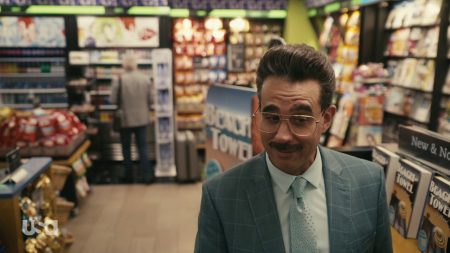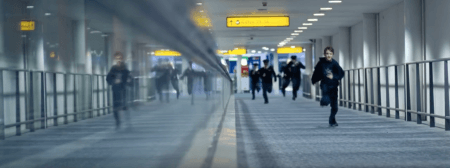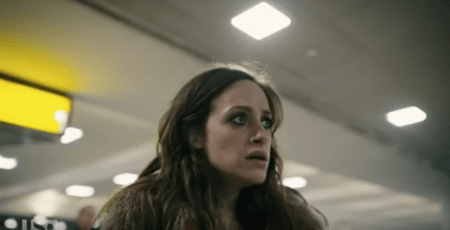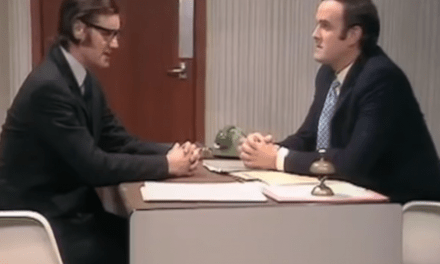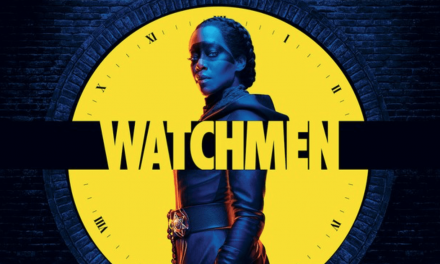In what follows, I wish to draw away from broader criticisms of Mr. Robot’s narrative consequences, and focus on a particular scene from Series 4, Episode 10, ‘410 Gone’. Importantly, the following analysis will serve to elucidate upon a number of important significances related to the series and its conclusion (this will be discussed next week). Before reading the below, however, it is worth watching the scene in question:
After spending a night together in season 3, Darlene convinces FBI Agent, Dominqiue DiPierro, that they need to leave the country. Though Dominque’s involvement with the Dark Army puts her under an FBI investigation, and while Elliot and Darlene are able to successfully redistribute the Deus Group’s wealth, all three remain in fear of a retaliation from the cyber-terrorist group. This is underscored when Dominique bumps into one of the Dark Army’s ‘former’ members – Irving (Bobby Cannavale) – at an airport bookstore. After leaving Elliot to track down Whiterose, Darlene and Dominique travel to the airport with the intention of fleeing to Budapest. However, upon speaking to Irving, who informs Dominique that the Dark Army is no longer interested in her or Darlene, Dominique decides not to flee. It is after making this decision that the above scene takes place.
Set against the tense atmosphere that has led to this moment, the scene offers a brief respite for an audience who have become accustomed to the series’ darker tones. Notably, the attraction that develops between Darlene and Dominique is one that stands disjointed amongst the series’ cynicism, where, based upon our knowledge of previous episodes, ‘romantic relationships’ usually culminate in the death of one of its members.
In addition, the decision to use the musician, Carly Rae Jepsen, and her pop-inspired track, ‘Run Away with Me’, remains a unique choice – indeed, Jepsen’s popular credibility and the track’s decidedly romantic tone offers a conspicuous contrast to the series’ soundtrack. What is significant, however, is how the use of the track serves to position the scene in accordance with the romantic-comedy genre; a genre which has frequently drawn upon the ‘airport chase’ sequence. (In fact, if we think of Love Actually [Richard Curtis, 2003], then we can better understand the contrast that this scene’s inclusion affords in Mr. Robot).
Nonetheless, what the scene provides is a certain reconfiguration of the ‘romantic union’ which usually occurs in Hollywood blockbusters. In effect, we can consider how the scene efficiently portrays the Lacanian assertion: ‘there is no sexual relationship’. In order to unpick this portrayal, closer attention will be given to the scene’s content and form.
Content and Form
Central to the scene’s action is the failure of both Darlene and Dominique to successfully cross paths and confirm their feelings for one another. After choosing to remain in the US – thus, leaving Darlene to travel to Budapest alone – Dominique decides to turn back and reunite with Darlene as she boards the plane. Yet, as we observe, Darlene’s panic attack causes her to leave the boarding queue, with Dominique taking her seat unaccompanied. As noted, the failed meeting plays out to Jepsen’s ‘Run Away with Me’.
What is notable, however, is the specific use of this track and its relation to the scene’s content and form. In contrast to simply examining the ‘content’ of a scene, Slavoj Žižek redirects attention to how this content is not ‘simply “depicted”’; but instead, ‘is directly “rendered” in the very form of the narrative’ onscreen (Žižek, 1989: 22, italics added). We see this in ‘melodramas’ when ‘the emotional excess that cannot express itself directly in the narrative lines finds its outlet in ridiculously sentimental musical accompaniment, or in some other formal features’ (Žižek, 2012: 306). In view of the above scene, we can see how the relationship between the scene’s ‘content’ is one that is dialectically represented in its ‘form’, most notably, in the formal adoption of a diegetic switch.
That is, as Dominique turns to leave, the track moves from the diegetic (being played from somewhere in the airport) to the non-diegetic (the transfer from the airport to the soundtrack); a transferal which takes place at about 0:16. At 0:54, the music moves completely to the scene’s soundtrack. Though the diegetic switch is used throughout the scene – for example, at 1:24, we hear the flight-call play over the track – at certain points in the narrative ‘content’ the track suddenly pauses. This can be seen at 1:28 when Dominique stands at the exit gate, with the pause clearly reflecting her deliberation as to whether to leave or join Darlene.
The significance of this diegetic switch is that it is clear that the use of the track is not simply accompanying the content onscreen, but, instead, provides a formal significance that excessively frames this content as well our own orientation to the scene (Žižek, 1989). In commenting upon the use of the soundtrack in film (specifically, Phillip Kaufman’s Invasion of the Body Snatchers [1978]), Žižek (1989) notes:
Bombarding us with details from every side, the soundtrack has in a sense taken over the function once exercised by the establishing shot. It gives us the general perspective, the ‘map’ of the situation, and guarantees its continuity, while the images on screen are reduced to isolated fragments, visual fishes swimming freely in the encompassing medium of the sound-aquarium. (1989: 19).
Whereas the images of Darlene and Dominique contemplating their decisions are portrayed as isolated shots – thus, emphasizing their separation – it is through the formal use of the Jepsen track that the scene’s orientation is given its narrative direction. When the two are debating the ‘risk’ in leaving together, therefore, admitting their sexual attraction to one another; or, when the romantic union fails to materialize, this content is dialectically accounted for in the track itself. That is to say, the formal use of the diegetic switch – the various pauses, and, the abrupt finish, which occurs as both Darlene and Dominique narrowly miss one another – serves to reflect and accentuate the content (the failed union) onscreen.
The significance of the scene’s failed union is that it bears witness to a certain ‘excess’ within the scene’s narrative content – primarily, the idealization of the romantic fantasy. Indeed, if we consider that this ‘excess’ cannot, as Žižek (1989, 2012) highlights, be fully portrayed in the narrative content (and vice versa), then, it is evident that the track’s musical composition as well as its formal application, each serve to establish the ‘excess’ that is usually attributed to the traditional Hollywood romantic fantasy. Importantly, this is not to suggest a unity between content and form, but, instead, a dialectical relation, from which what cannot be conveyed in ‘content’ is brought to bear through its ‘form’.
This is underscored when we imagine the scene without this ‘excess’ (without any music accompaniment, just the diegetic sound of the airport), or even with a more traditional ballad, a Whitney Houston number, for example. In both cases, the action onscreen would seem flat, and, in the use of Houston, ridiculously sentimental. Instead, the combined use of Jepsen (an artist known for her unashamedly ‘pop’ credentials), alongside the track’s ‘synth-pop’ tempo (which underscores its ‘romantic nostalgia’), help to formally ground the scene’s ‘dramatic’ content – thus emphasizing the ‘will they, won’t they’ tension of the chase sequence. Yet, it is here that the track’s excess, rather than promising the successful romantic union, disavows its own failure; its own lack of completion by the scene’s end. It is on this basis that Mr. Robot affords its own ideological critique.
The Romantic Fantasy – An Ideological Critique
In commenting upon the films of David Lynch, Todd McGowan notes how:
At the moment of the seeming achievement of the successful sexual relationship, the films of David Lynch force us to encounter the real impossibility of this relationship. Rather than showing us the subject realizing its desire with an object that allows the subject to complete itself, they depict an object that doesn’t fit in the subject’s world. In the encounter with the objet petit a, the subject experiences the object as a jolt throwing it off balance. This encounter with the gaze also throws the spectator off balance, as it exposes the spectator’s own investment in the logic of the fantasy. (McGowan, 2007: 205).
Following the above, I wish to argue that this ‘jolt’ – the gaze – is reflected in our spectatorial relation to the failed union. As discussed in the Introduction, our encounter with the gaze is one that is brought to bear, and thrown off balance, when the track itself abruptly pauses or emphatically ends.
It is this formal use of the track which serves to underscore the scene’s ability to portray the failure of the sexual relationship (the failure for both Darlene and Dominique to successfully unite and travel to Budapest). Again, McGowan (2007) notes:
The illusion of the successful sexual relationship marks the fundamental ground of contemporary ideology: even subjects skeptical about everything else often invest themselves in this fantasy. Its power stems from its ability to provide the subject with a sense of completion – or with a sense of the possibility of completion. In the romantic union, the subject imagines that it will find what it lacks and thereby experiences the ultimate enjoyment. As long as subjects invest themselves in the fantasy of this union and in the idea of the ultimate enjoyment, they remain subjects of ideology. (2007: 203).
Though the Hollywood ‘romantic-comedy’ is one predicated on the spectator’s investment in the fantasy onscreen, there are also moments in film and television when the ideology underlining this fantasy can be challenged. This occurs in those texts where some ‘excess’ is made ‘visible’ in the text’s formal construction (Vighi, 2009). In the case of the ‘airport-chase’ sequence, our investment in ‘the fantasmatic scenario’ – i.e. our investment in the successful (re)union between Darlene and Dominque – is one that ‘ex-poses the excessive enjoyment inherent – though invisible – in the functioning of the social order’ (McGowan, 2007: 37). In other words, it is through framing and realizing this enjoyment that our ideological commitments can be laid bare, and, ultimately, subverted.
In this final scene between Darlene and Dominique, we do not get the successful romantic union; instead, we see the failure of this union performed when both women narrowly miss one another. Here the abridgement of the onscreen fantasy (the romantic union) – revealed in Darlene’s (and our own) desire for Dominique to join her; the romantic tension created when Dominique declines, leaves, but then, subsequently turns back; and, the ending which confirms the failure of the union itself – all serve to propagate, extend and undermine the romantic fantasy. Echoing what McGowan (2007) refers to as the ‘cinema of intersection’, this narrative is effectively achieved in the tension afforded between the scene’s content and form. In doing so, the performance of the scene brings to light ‘the structure of fantasy in its entirety, from its emergence to its dissolution, … allow[ing] spectators to experience the failure of the sexual relationship rather than its success’ (McGowan, 2007: 204, italics added).
It is in accordance with this ‘failure’ that the relation between content and form in television analysis can be employed to expose the fantasies that underscore our ideological relations. Ultimately, the adoption of the diegetic switch and the excessive framing of the fantasy-content, afford a political valence which helps lay bare the gaps and inconsistencies in the scene’s formal structure. We will return to the ideological significance of this critique in next week’s final post.
Jack Black is a Senior Lecturer examining the interrelationships between sociology, media and communications and cultural studies. Drawing upon ‘traditional’ media forms (newspaper analysis) as well as television and film studies, Jack has examined a range of topics including nationalism/national identity; multiculturalism; and, collective memory. With particular attention afforded to the relationship between philosophy and critical social theory, this research expands upon the effects of ideology and power on culture and media representations.
References
McGowan, Todd, The Real Gaze: Film Theory After Lacan. (New York, NY: State University of New York Press). 2007.
Vighi, Fabio, Sexual Difference in European Cinema: The Curse of Enjoyment. (Basingstoke, UK: Palgrave Macmillan). 2009.
Žižek, Slavoj, “The Undergrowth of Enjoyment: How Popular Culture Can Serve as an Introduction to Lacan.” New Formations. 9: 7-29. 1989
Žižek, Slavoj, Less than Nothing: Hegel and the Shadow of Dialectical Materialism. (London, UK: Verso). 2012.


